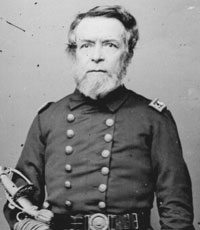Andrew Hull Foote (1806-1863)
Andrew Hull Foote (September 12, 1806 - June 26, 1863) was an admiral in the United States Navy who served during the American Civil War.
 Andrew Hull Foote was born on September 12, 1806, in New Haven, Connecticut. Young Andrew Foote was eager for the military life. After attending West Point for a short time in 1822, he joined the navy as a Midshipman in 1822 at the age of 16. Foote was deeply religious, and, while in the navy, began campaigning for temperance and the abolition of slavery.
Andrew Hull Foote was born on September 12, 1806, in New Haven, Connecticut. Young Andrew Foote was eager for the military life. After attending West Point for a short time in 1822, he joined the navy as a Midshipman in 1822 at the age of 16. Foote was deeply religious, and, while in the navy, began campaigning for temperance and the abolition of slavery.
While in the navy, Foote traveled the world including China, Africa, and the South Pacific. He saw action in each location including an anti-slavery patrol that had trouble with restrictive laws (American slavers intercepted by foreign ships had to be released. This required the US Navy to work closely with the British Navy). From 1856 to 1858, he commanded the Portsmouth in the East India Squadron. On November 20-21, 1856, Foote led a landing party that seized the barrier forts at Canton, China, in reprisal for attacks on American ships.
When the American Civil War began he was in New York, on more mundane duty in charge of the Brooklyn Navy Yard.
In August 1861, at the outset of the Civil War, Foote was put in charge of naval defense on the upper Mississippi River by his friend, Navy Secretary Gideon Welles. From August 30, 1861, to May 9, 1862, he commanded the Naval Forces on Western Rivers with distinction.
Foote was charged with naval defense which include the building and manning of ships, and leading them into action. Even though the fleet was improvised from whatever ships could be converted or built in a hurry, Foote was brilliantly effective in command.
His first major operation was the February 1862 attack on Forts Henry and Donelson with U. S. Grant. The plan called for a coordinated attack with both the army and navy, but when Foote arrived at Fort Henry on February 6, 1862, he found the Confederate defenses lacking and he decided to act. With the river in flood, Foote sailed straight into the fort and the Confederates surrendered.
Grant moved forward to attack Fort Donelson, but he opened the attack too soon. Foote arrived late and when he finally arrived he went straight into action on February 14. During the battle he was wounded in the foot from splinters. While the Confederates repulsed Foote's attack, Fort Donelson eventually fell and Foote received much of the credit.
His next action was the attack on Island Number 10 which held a commanding position in the middle of the Mississippi River. During the battle he remained on duty, although he was on crutches during the attack on Island No. 10 his old wound forced him to move to a shore position.. His health deteriorated so far that he had to step down from command, and was replaced by Capt. Charles H. Davis.
In June 1862, Foote moved to Washington, promoted from commodore to rear admiral and on July 16, 1862, given the Thanks of Congress. His new charge was chief of the Bureau of Equipment and Recruiting in Washington, D.C.
A year later he wangled himself a sea-going appointment: the command the South Atlantic Blockading Squadron outside Charleston, South Carolina. He died June 26, 1863 at New York before he could take his position in the blockade off Charleston.
 Andrew Hull Foote was born on September 12, 1806, in New Haven, Connecticut. Young Andrew Foote was eager for the military life. After attending West Point for a short time in 1822, he joined the navy as a Midshipman in 1822 at the age of 16. Foote was deeply religious, and, while in the navy, began campaigning for temperance and the abolition of slavery.
Andrew Hull Foote was born on September 12, 1806, in New Haven, Connecticut. Young Andrew Foote was eager for the military life. After attending West Point for a short time in 1822, he joined the navy as a Midshipman in 1822 at the age of 16. Foote was deeply religious, and, while in the navy, began campaigning for temperance and the abolition of slavery.